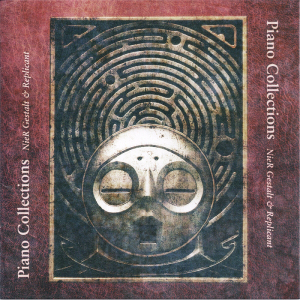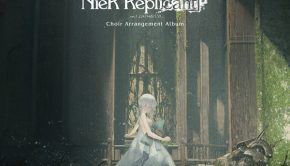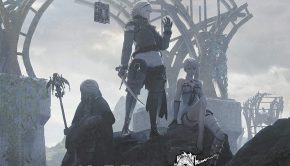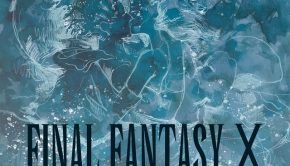Nier Gestalt & Nier Replicant Piano Collections
 |
Album Title: Nier Gestalt & Nier Replicant Piano Collections |
| Record Label: Square Enix |
|
| Catalog No.: SQEX-10303 |
|
| Release Date: March 21, 2012 |
|
| Purchase: Buy at CDJapan |
Overview
The music of NieR has been one of Square Enix’s most successful soundtracks in recent years, even though the game was externally developed and commercially disappointing. Most attribute this to the focus on the wonderful vocals of Emi Evans, as well as the lush and diverse soundscapes of the music, that accompanies them. Since the original soundtrack, the music of NieR has seen an album featuring some basic arrangements of the music (as well as some electronic versions to fit downloadable content for the game), as well as a tribute album that was quite experimental yet well-received. The latest for the series is the Piano Collections, featuring arrangements by Monaca composers Keigo Hoashi, Ryuichi Takada, and Yuri Misumi, as well as guest arrangers Kumi Tanioka and Masato Kouda. Given the lack of vocals and complex soundscapes, how does this effort turn out and is it worth a purchase?
Body
The album opens up with “Song of the Ancients” arranged by Keigo Hoashi. For the most part, it’s a fairly straightforward arrangement, clearing showcasing the powerful original melody. However, those moments of deviation are what give the arrangement a bit of a wispful, airy sound. Because the music has been arranged many times, he told me wanted to focus on creating simple piano arrangements that showcased the strength of the melodies. This is apparent through all of his arrangements. Each of the themes manages to provide a wonderfully simple, but equally entrancing take on the originals, from “Emil” and its romantic, interpretation that gives off a feeling of hope to “Kaine” and its dreamy soundscape. “Snow in Summer” offers a contemplative atmosphere that really captures that desolate, yet fantastical feeling heard in the original and conjures up images, at least to me, of “Moonlight Sonata” by Beethoven, in terms of how the accompaniment and melody lines work together to create something magical. “Repose” is an exquisitely beautiful piece that manages to capture a feeling of relaxation and rest. Unlike most of the pieces, that have some sort of elaboration, this one chooses to be more straightforward, but still manages to come off as extremely satisfying.
However, Keigo Hoashi’s crowning achievement on this album is definitely his conversion of “Shadowlord” to a single instrument. Given that the original had two very distinct sections, a calm, haunting section focusing on haunting choral work and a section adding in bombastic orchestration to give it a sense of battle, it was interesting to see how Hoashi would handle this one, particularly the latter portion of the original. The beginning, as expected, manages to capture that haunting element. However, rather than try to match the style and intensity of the original in the latter half, he manages to keep the piece relatively subdued, yet still able to exude that power due to his performance.
There were also some guest arrangers on the album, namely Kumi Tanioka and Masato Kouda. Masato Kouda, with Kumi Tanioka as performer, arranged “Grandma.” This is an extremely beautiful piece of music, offering some slight jazz influences, particularly in the performance, while at the same time, having a very classically oriented arrangement that is reminiscent of Chopin and conjures up an extremely beautiful and mysterious atmosphere. Of all the traditional piano arrangements on the album, this is definitely one of the most interpretative and is probably my favorite arrangement on the album.
Kumi Tanioka handles two distinctly different pieces, “Hills of Radiant Wind” and “Gods Bound by Rules.” The former, one of my favorites on the original soundtrack, captures that carefree, spirited sense of the original, sounding as if the music itself is being carried by the wind. After the delicate opening, the tempo matches that of the original piece, becoming a bit more powerful. While the piece itself is quite straightforward, Kumi Tanioka manages to throw in a surprise or two. One of my favorite surprises is that in portions of the arrangement, she intentionally plays every other melody note, which may seem odd to fans of the original, but I found myself filling in the blanks, as I listened along in my head. The latter, “Gods Bound by Rules” is my favorite of Tanioka’s two arrangements. Compared to the other pieces on the album, this one stands out due to its intense nature. While the opening is very delicate, the rest of the arrangement is equally as powerful as the original, with Tanioka pounding on the keys to match the sheer ferocity of the original while also providing more romantic passages, particular during the A section of the melody. The mix between more delicate, airy passages and the intensely powerful sections really makes it seem that Tanioka is pouring her life force into her performance, something that Keigo Hoashi noted during the Ustream event for the album’s release.
The last two pieces of the album were arranged by Ryuichi Takada and Yuri Misumi. Unlike the rest of the album, these two pieces were played on a different piano and also employ techniques that aren’t on a traditional piano collections album. As such, they tend to be a bit more interpretative. Takada’s arrangement of “The Wretched Automatons” features distorted electronic tones and percussion. As for the piano portion of the piece, it definitely has a bit more of an emptiness compared to the original, mainly due to its tempo, but overall it’s enjoyable. The last piece, “Ashes of Dreams,” by Yuri Misumi, sounds as if it is being played on a phonograph. It definitely has that sound of a musical era that has passed, but I think it fits with the jazzy arrangement, given its popular back in the earlier half of the 20th century. Given that these two pieces employ techniques not common on a piano album and the fact that the piano is different from the rest of the album, these pieces seem more like bonuses, rather than bona fide piano arrangements, but they are welcome in my eyes.
Summary
Converting the original music of the NieR universe, which was extremely popular for its vocal focus, is a daunting task. Producers didn’t want to alienate the fans of the originals, but at the same time, wanted to draw people in who aren’t necessarily familiar with the music. I think that this album is quite successful as a piano album, offering a range of simplistic piano arrangements to more elaborate ones, providing a nice array of diversity, while staying true to the powerful nature of the originals. While it may not be for everyone, especially those who fell in love with the vocal aspect of the original soundtrack, it’s definitely worth sampling for all fans of NieR, with their opinion ultimately deciding whether or not it was worth the purchase. For me, it certainly was.
Do you agree with the review and score? Let us know in the comments below!
4
Posted on March 21, 2012 by Don Kotowski. Last modified on September 20, 2014.














